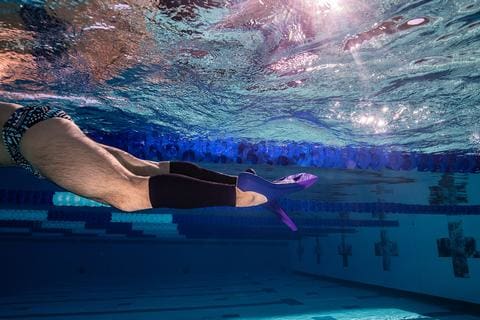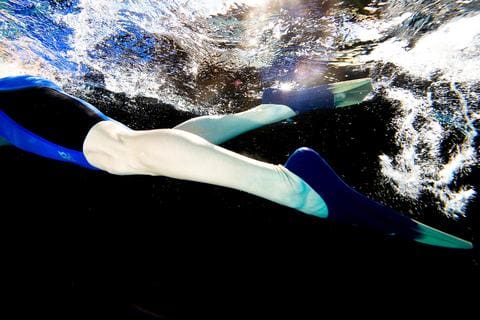8 Benefits of Swimming with Fins
Improving your technique and performance with swim fins
Looking for swim workouts and training plans? Get the MySwimPro app and take 20% off an ELITE membership code "A3PERFORMANCE". Redeem Coupon >
Sometimes it’s hard to know how or when to use your swim equipment to get the biggest bang for your buck. Each piece of equipment can improve some technical or training component to your swimming.
If there’s one item in the equipment bag that’s the best for improving technique and performance, it’s the fin!
Here are 8 benefits to swimming with fins:
1) Improved Kick Technique
If you’re like most swimmers, then your kick might be the worst part of your swim training. Whether it’s with a kickboard or in streamline, you seem to go absolutely nowhere. This has less to do with your leg strength and the most to do with your kick technique.
A proper kick technique (flutter) is narrow and compact. The best kick is short and fast, rather than big and powerful. Your legs are essentially straight and the power is generated from the hips. Toes should be pointed. The weakest part of the kick that fins help improve, is the up-kick.
The ‘up-kick’ of the motion of the kick that engages your hamstrings, glutes and lower back muscles. Adding resistance to this range of motion helps improve your technique by providing you with the positive muscle reinforcement (and propulsion) to make you more efficient and faster.
2) Improved Ankle Flexibility
An efficient kick has a small amplitude. Your toes should separate no more than 12” during any part of the kick. To do this, you need straight legs and most importantly a high level of ankle flexibility. This is something that only develops over time, and some swimmers are naturally more flexible than others.
Applying fins to kick training and swimming will dramatically increase your ankle’s adaptation to a more efficient flutter and dolphin kick. The added resistance of the fins will reinforce proper kick mechanics so you improve faster than kicking or swimming without fins.

3) Reduces Shoulder Stress
Swimming is a very low-impact sport compared to land-based physical activity. That’s not to say your shoulders don’t take a beating. With so much repetitive movements, the shoulders are bound to give out. We recommend adding a strength training component to your swim program.
In addition to strength training out of the water, adding a pair of fins to your workout will lessen the impact to your shoulders. Whether you’re swimming or kicking, the fins give you added propulsion that lessen the load on your upper body and allows you to work on improving technique.
4) Improved Body Position
One of the key differentiators between swimmers of different levels (Olympic to novice) is body position in the water. When you watch an elite swimmer cruising through the water they look like a speedboat that was designed to maintain high elevation in the water. Most swimmers do not hold this body line, but swimming with fins can help.
Swimming with fins improves body position by adding velocity to the stroke and also teaching the body how to swim faster on top of the water. This works with kicking as well – when you’re in streamline on your back or front, you’ll be able to holder a higher body line with the added propulsion of fins.
5) Improved Stroke Technique
Swimmers of all levels incorporate fins into their training because it can help improve stroke mechanics in every stroke. The added propulsion and stability of fins allow you to focus on specific components of the stroke that you’re working on. Completing drills with fins allows you to have a more realistic feeling of speed while isolating one part of the stroke to work on.
Fins also allow you to do more advanced drills you otherwise may not be able to do without fins. For example, single arm freestyle or backstroke is very difficult without the added propulsion of fins for most swimmers. This is a fantastic drill to work on balance and the arm pull for both freestyle and backstroke.
6) Increased Strength and Endurance
There’s no question you can swim faster with fins. Fins allow you to experience an unimaginable feeling of speed. You can move through the water at a velocity otherwise not possible. Fins not only make you swim faster, they allow you to swim and kick for longer periods of time building endurance.
The added resistance of fins builds strength and power. Muscle recruitment is at an all-time high under the stress of fins, and this is why fins are a fantastic way to improve multiple components of your swimming at the same time.
7) More Efficient Workout
If you’re pressed for time, then making sure you get the most out of your time in the water is crucial. Fins allow you to get more work done in less time. You can elevate your heart rate much faster by adding equipment like fins and get your body into a higher heart rate zone for longer in a shorter period of time. #SwimSmarter
8) It’s More Fun!
Swimming fast is fun! It’s also fun to mix up a workout with the added use of equipment like swim fins. For example, if you do a set twice through, on the first round you can go ‘all natural’ and on the second round you can add a pair of fins, and swim even faster. There are a number of different ways you can vary workouts with fins. You’re only limited by your own creativity.
How To Choose Fins?
When it comes to choosing a pair of fins, you have two main considerations: Fin Length, Flexibility.
Fin Length
The length of your fin is the most important consideration when choosing fins because it can dramatically impact how they affect your stroke technique and speed. Traditionally shorter fins are best for every day kicking and swim training. Longer fins are better for working on underwater dolphin kick and learning body undulation.
Shorter fins give a more realistic feeling of speed and help refine stroke technique while delivering maximum cardiovascular conditioning. Longer fins allow you to go fast at a reduced kick tempo which is often the opposite benefit you’re looking for.

Flexibility
At the end of the day (or workout), you need to be comfortable. Stiff fins can make you really fast, but also feel like bricks on your feet. This can cause muscle pain and over fatigue you. If the fins are too soft, they’ll bend too much when power is applied to them and you’ll have a reduced benefit. The right firmness and flexibility comes down to your preference and strength level.
Wear socks?
If fins cause blisters for you, there are all types of socks designed specifically for this purpose. Ideally, you don’t need to result to these because you’ve found a pair that fits and isn’t too firm.
Positive Drive Fin
These fins are suitable for all four competitive strokes. They have a unique ellipsoidal blade that allows you to have the correct kick propulsion for every style of kick: Dolphin, Flutter, and Breast. These are a useful pair of fins to have in your equipment bag if you’re a breaststroker or Individual Medley swimmer. For butterfly or flutter kick, we recommend more traditional short/long fins.
(F)in Summary
It can be really hard to take your fins or paddles off after a set or workout. It’s important not to become overly subscribed (addicted) to your fins or any piece of equipment.
If you’re a more experienced swimmer and you’re looking to get faster, keep your equipment usage to less than 50% of your total workout volume. Some days you may go over, other days, you’ll be under, but keep an eye on how often you’re using your equipment and it will make a big difference in your ability to transition on and off of your swimming toys.
Don’t be afraid to use multiple pieces of equipment together on sets. Use your swim fins to help improve ankle flexibility, develop a more balanced kick, fix your body positioning in the water, and of course, drown the swimmers in the next lane with your massive wake.
Have fun and happy swimming!
Looking for swim workouts and training plans? Get the MySwimPro app and take 20% off an ELITE membership code "A3PERFORMANCE". Redeem Coupon >
